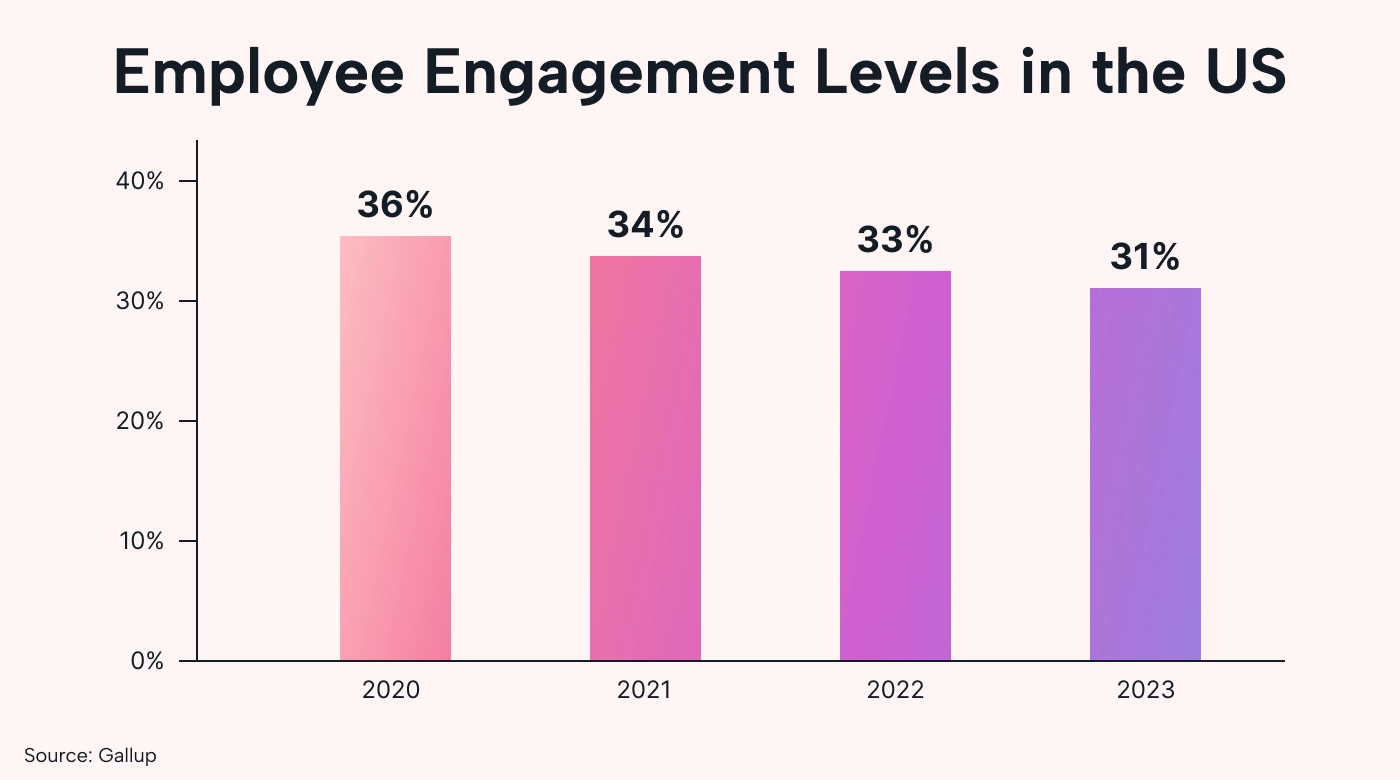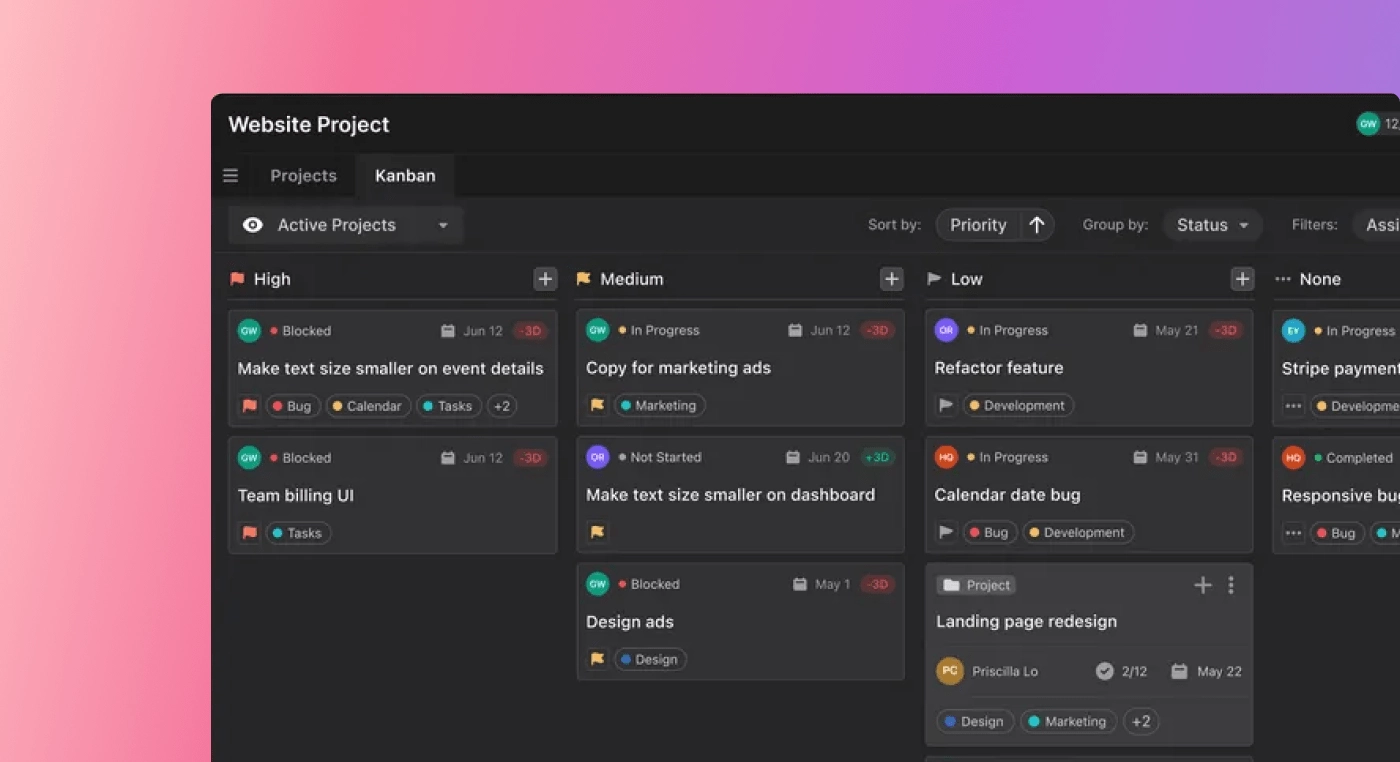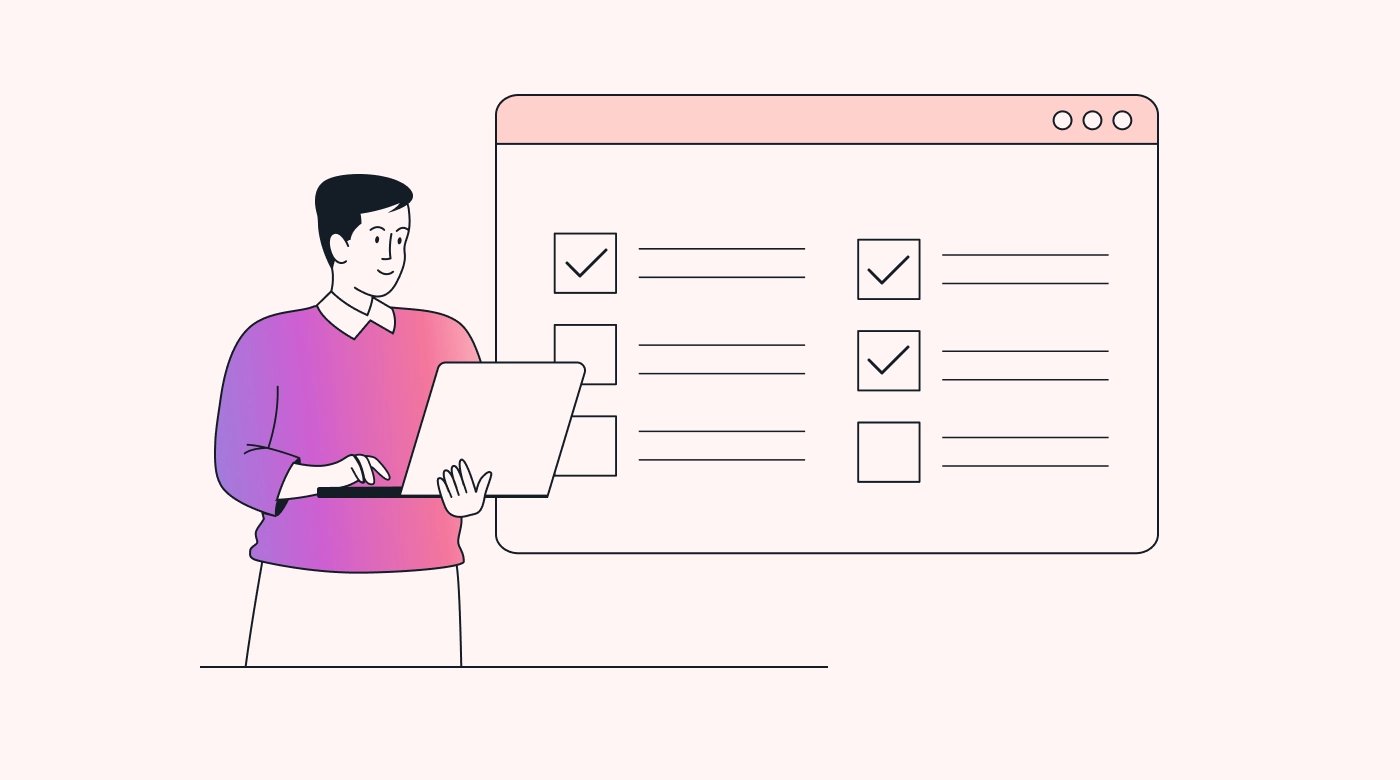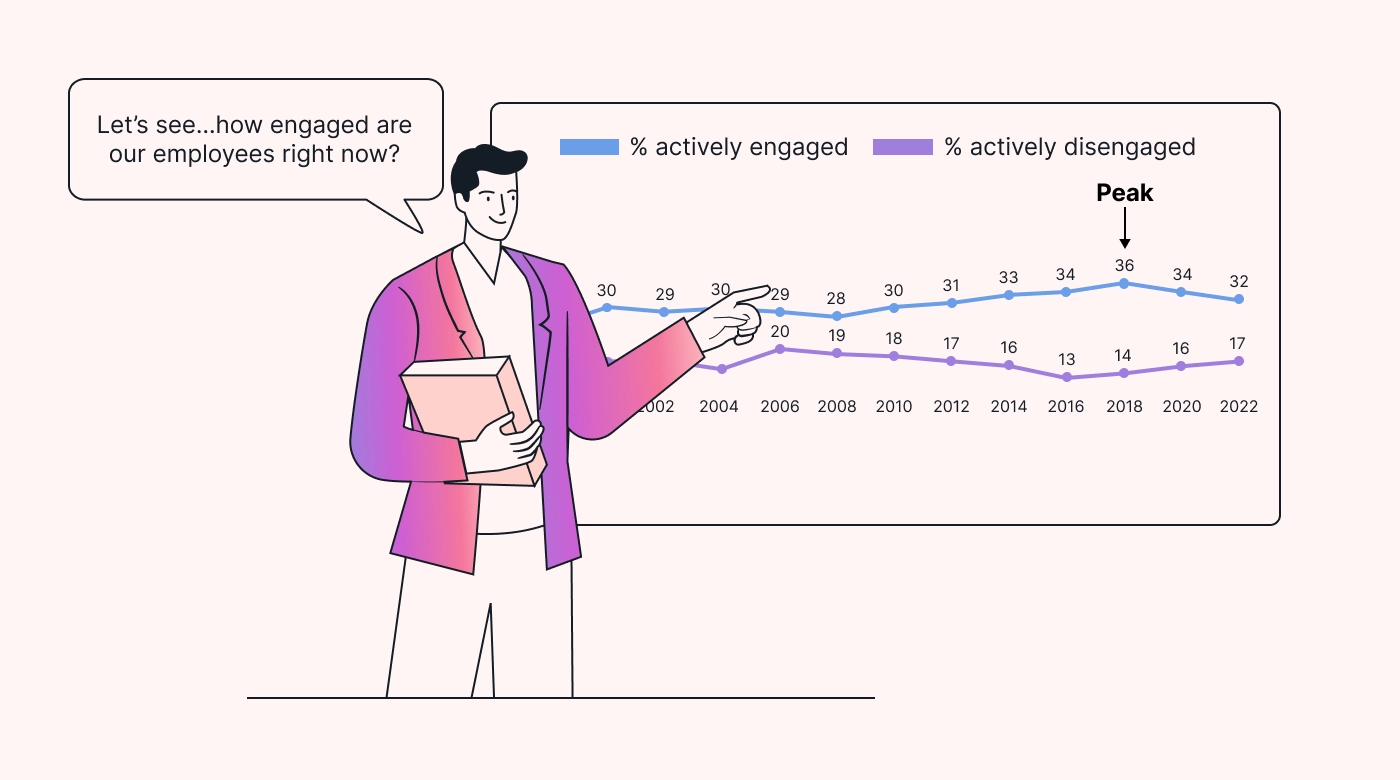As a business owner or HR professional, you may have noticed a troubling trend of dropping employee engagement levels within your organization. This dip not only affects productivity but can also erode company culture.
The good news is that there's a modern solution at your fingertips: employee engagement tools.
These apps are designed to revitalize your workforce and build a more connected, motivated, and satisfied team. From better communication to employee feedback technology, the right set of tools can help you address your employee engagement challenges head-on.
Let's explore how these tools can get your workplace humming again.
What are employee engagement tools?
Employee engagement tools are software applications and platforms organizations use to increase interactions among their workforce and reach higher levels of employee motivation and satisfaction.
Their purpose is to improve the overall workplace environment, with the intended outcome of sustainable productivity, better workplace morale, and higher employee retention rates.
Why is employee engagement such an issue these days?
To answer that question, let’s step back for a moment into the not-too-distant past.
In the 1900s, loyalty to one’s employer was typically a lifelong commitment. Many employees spent decades or their entire careers at one company.
This loyalty was driven by a combination of cultural expectations (staying with one employer was just what people did) and the rewards of job security and a steady career progression.
In this context, employee engagement wasn’t really an issue.
However, this dynamic has changed because of shifting attitudes toward work and the influence of technology.
The modern workforce, especially among younger employees, is now more individual-oriented. Employees place more emphasis on a good salary right from the start, personal growth opportunities, a healthy work-life balance, and meaningful work. These goals trump long-term loyalty to a single employer.
Research proves this fact. Just look at the alarmingly low engagement numbers below collected by Gallup, which has been tracking employee engagement and job satisfaction in the US for over two decades.
In 2000, Gallup found a 26% “engaged employees” rate, coupled with an 18% “actively disengaged employees” rate. Engagement has hovered around 30% from that point onward and peaked in 2020 at 36% — only to start declining again since.
 |
This shift in engagement is reflected in higher turnover rates. Workers are more willing to change jobs quickly to meet their personal and professional goals.
How has remote work intensified this situation?
On top of these general trends, the rise of remote working has introduced new challenges for employers in terms of keeping their employees engaged in their tasks and the company at large.
While remote work offers flexibility and can improve employees’ work-life balance, it can also lead to feelings of isolation and a disconnect from the company culture. This makes employee engagement both more critical than ever and harder to achieve.
Many companies are looking for ways to deal with these changes — and new engagement technologies are just part of a modern solution.
In what ways can companies benefit from employee engagement tools?
Let’s start answering this question by looking at the employee’s perspective.
Imagine you're part of a vibrant team where everyone's ideas are heard, achievements are celebrated, and personal growth is nurtured.
Here’s what it takes to make this magic happen:
First up is communication. This is the heartbeat of any thriving team. Teammates need to be able to freely share ideas, updates, and even a good laugh every so often. This keeps everyone in the loop and feeling connected.
Feedback opportunities are equally important. Employees must be able to voice their thoughts and be heard by their managers — in fact, this is just as crucial as the other way around. This two-way street fine-tunes the work environment to better suit employees’ needs and aspirations. As a result, their jobs are more enjoyable and fulfilling.
Recognition is another key. Getting an actual or virtual high-five for individual achievements can brighten employees’ days and spur them on to do even greater things.
 |
Thirdly, there’s the issue of personal growth. Employees do better in an environment that offers learning resources and development opportunities. This makes them feel like they can grow and thrive in their careers.
The good news is that employee engagement tools can help in all these areas and more.
In a nutshell, companies benefit from employee engagement solutions because these new technologies can help them create a workspace where employees feel valued, connected, and excited to contribute.
Employee engagement tools: A detailed overview
By now, you might be thinking, “So, what specific employee engagement tools do I need for my company?”
To find your way through the maze of tools out there, we’ll group them by category and describe what they can do.
We’ll also add a few handpicked examples of tools in each category and their key features. This will make it easier for you to choose the tools you need to shore up weak engagement areas at your company.
1. Communication tools
Communication tools are designed for clear and continuous dialogue within teams and across the organization. They support information sharing and project collaboration, and they also strengthen the sense of community that’s needed to keep remote and hybrid workplaces functioning well.
Software examples
- Slack: A versatile collaboration tool that includes real-time messaging, file sharing, and integration with other work apps.
- Microsoft Teams: Combines chat, video meetings, file storage, and application integration for more integrated teamwork.
- Zoom: Offers video conferencing, webinars, live chats, and a whiteboarding tool to make remote meetings more engaging and personal.
- Discord: Was initially popular among gamers primarily but now supports workplace communities with voice, video, and text communication.
- Mattermost: An open-source, self-hostable online chat service with file sharing and search functions, as well as integrations. It’s designed for high-trust environments and offers extensive customization and security features, making it ideal for companies with strict data control requirements.
- Chanty: A team chat app for basic communication and collaboration. It offers organized conversations, voice and video calls, and a teambook feature to keep all shared content in one place.
2. Collaboration and project management tools
These tools are designed to improve teamwork through better project coordination, task tracking, and workflow management. They help teams stay organized and aligned on their goals, contributing to a more efficient and engaging work environment.
Software examples
- Motion: Intelligent, AI-driven project management software that measures how much your team can accomplish and builds every teammate a prioritized, customized schedule.

- ClickUp: Offers a single platform for tasks, documents, goals, and messaging for increased productivity and engagement.
- Smartsheet: Combines elements of project management with spreadsheet-like flexibility for better visibility across tasks.
- Trello: A visual project management tool that helps teams organize tasks and projects in a collaborative way.
- Asana: Streamlines team-based project coordination and work management.
3. Social and community platforms
These platforms are designed to build a stronger sense of community and belonging among employees through social connections and interpersonal engagement beyond work-related tasks.
Software examples
- Workplace from Meta: Creates a private social network for your organization that makes it easy to share news, exchange knowledge, and engage in social interactions.
- Microsoft Viva Engage (formerly Yammer): A social networking tool for enterprises focused on open communication and collaboration across departments.
- Slack Huddles: A feature within Slack for impromptu voice and video conversations. It can be used as a replacement for the casual, spontaneous chats that happen at physical offices.
- Guild: A platform for professional groups, networks, and communities that offers a space for meaningful, focused discussions.
4. Recognition and rewards platforms
These platforms are all about celebrating employee achievements and acknowledging their best efforts, both of which are vital for keeping employee morale high.
Software examples
- Bonusly: A tool for building a high-performing culture by means of peer recognition and rewards.
- Recognize: A social platform for employee recognition.
- Kudos: Focuses on peer-to-peer recognition programs to strengthen team relationships and employee engagement.
- Assembly: A recognition and engagement platform that helps you build a positive workplace culture.
- Reward Gateway: Combines recognition with rewards, communication, and surveys.
- Motivosity: Promotes a culture of appreciation through employee recognition and rewards.
5. Feedback and survey tools
The purpose of these platforms is to make it easy for businesses to gather actionable feedback from their employees on different aspects of the work environment. Employers can use the data from the survey questions to make workplace improvements that increase employee satisfaction and engagement levels.
 |
Software examples
- SurveyMonkey: An easy-to-use, versatile tool for creating employee engagement surveys.
- Google Forms: A straightforward platform for making surveys and quizzes.
- Culture Amp: Specializes in employee feedback and performance to drive culture and engagement improvements.
- Qualtrics XM: Offers sophisticated employee experience and feedback surveys.
- Typeform: Creates interactive surveys and forms that can improve survey response rates and solicit higher-quality feedback from employees.
6. Performance management systems
These systems are designed to help with goal setting and performance appraisals. They typically include options for continuous feedback, which helps employees see how their individual achievements contribute to organizational objectives.
Software examples
- BambooHR: Simplifies HR tasks while providing actionable insights into employee performance and engagement.
- Lattice: Supports goal-setting, 1-on-1 check-ins, and continuous performance management.
- Betterworks: Offers tools for goal-setting, performance tracking, feedback, and conversations.
- 15Five: Based on the principle of spending 15 minutes writing reports and 5 minutes reading them, this engagement tool is designated to improve communication and performance.
- Reflektive: A performance review and management platform that encourages real-time feedback and goal setting.
7. Learning and development platforms
These platforms offer a wide array of resources for personal and professional growth. You can use them to give your employees continuous opportunities for learning and skill development.
 |
Software examples
- LinkedIn Learning (formerly Lynda): Provides a wide range of courses for skill development and professional growth.
- Coursera for Business: Offers access to courses from universities and colleges that can contribute to ongoing employee skill-building.
- Udemy Business: Features an extensive library of courses on a variety of professional skills.
- Skillshare: Offers creative and business classes for lifelong learning and skill development.
- Pluralsight: Helps teams stay updated and trained on the latest tech developments.
8. Well-being and health programs
These programs support employees’ physical and mental health. Employers can use them to strengthen the link between employee well-being and engagement.
Software examples
- Virgin Pulse: Is designed to help employees adopt healthy habits and a greater sense of well-being.
- Headspace: Offers mental healthcare services for businesses, including mindfulness and meditation resources to reduce stress and improve focus.
- Calm Business: Provides meditation and mental health resources to improve employees’ well-being and performance.
- Wellable: A holistic wellness platform that supports physical and mental health initiatives in the workplace.
9. Employee engagement software
In addition to the targeted engagement tools discussed above, there’s also an employee engagement platform category with tools specifically designed to monitor and improve employee engagement levels.
These platforms' reporting features provide useful insights so the leadership team can make informed decisions related to employee engagement.
 |
Software examples
- Officevibe from Workleap: Gathers employee feedback to improve workplace culture and engagement.
- TINYpulse: Provides valuable insights into employee sentiments as part of its mission to build a culture of feedback and recognition.
- EngageRocket: Offers analytics and insights for improving workplace engagement and performance.
- Peakon from Workday: Collects employee feedback in real time and offers insights into engagement and productivity strategies.
Select the right employee engagement tools for your company
From communication tools to feedback surveys, you have a lot of options. While there are plenty of nice-to-have engagement apps on this list, there are also a few that are must-haves for busy teams.
Motion keeps your team on track with AI-powered task management. Your employees stay focused on what matters most, every hour of the day, whether it’s deep work, meetings, or even wellness breaks to recharge during the day. As a result, they’re more productive, more satisfied, and less stressed.
If you’re looking for dynamic, intelligent project management software that will connect your employees like never before and save you valuable time in the process, then Motion is here to help. Try it for free for 7 days.

A certified content writer and SEO strategist, Carla Groenewegen writes about success principles and practices aimed at SMBs and not-for-profit organizations.




